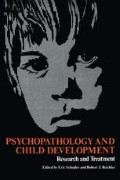Abstract
Play has been described as the language of the child and, like the adult’s dream, may be considered the royal road to his unconscious (Erikson, 1950). Play, like language, serves an intrapsychic as well as an interpersonal function; it is a means by which the child resolves inner conflicts; it enables him to master the passively experienced traumatic events of his macrocosmic real world by actively repeating them in his microcosmic play world. Play is also a means of communicating these inner events and is thus object-directed, particularly in instances where the child has already achieved the capacity for more advanced object relations. Play helps develop and strengthen structures capable of delay functions, and thus furthers the future development of adaptive goal-oriented behavior. Play can be described in terms of its content—the play, as well as its structure—the Spielraum, or play space (Erikson, 1940). Through his play and through his playing, the child recreates his life space, the meaningfully cathected experiences of both his inner and outer worlds, in the microcosmos of the play space. The child’s earliest autoplay with his body can be understood in terms of the beginning individuation experience, and his playing, with the notion that there is a self and object; fingers and toes that are “me-here,” a nipple and milk that are “her-there.” Somewhat more advanced play was described when Freud (1955) observed a child roll a spool of thread back and forth, accompanied by the words, “gone; there,” thus reflecting the child’s attempts to master the notions of separation and reunion. Such playing indicated that the child had begun to establish a capacity for object constancy, so that out of sight was not completely out of mind; in fact, was helped to remain in mind, so to speak, through the very act of playing. Parenthetically, that play was expressed on a particular level of communication—that of play action—(Ekstein and Friedman, 1966) in which fantasies are woven around a toy. Such play reflects a fairly advanced level of psychic structure and functioning that is not always available to the schizophrenic child. Ekstein and Friedman (1966) refer to a schema for ordering different levels of communication, indicating the progressive development of the capacity for goal-oriented thought as it evolves and advances from the initial phase of pure impulse expression to higher levels, such as acting out, role play, and rational fantasy.
Der Mensch braucht freien Spielraum, um spielend eigenes Denken und Wissen, eigene Kultur, Menschenkultur zu gebären. Ein weiter Spielraum sei dem Menschen die Welt. . . . Jedwed Ding sei ihm ein Spiel, und das Spiel sie ihm heiliger Ernst.
-frei nach Georg Groddeck, 1902
[Man requires free play space in order to give birth playfully to his own thinking and knowledge, his own culture, man’s culture. The world be a wide play space to man. . . . Everything be a play to him, and play be to him holy and serious. ]
-Freely after Georg Groddeck, 1902.
Access this chapter
Tax calculation will be finalised at checkout
Purchases are for personal use only
Preview
Unable to display preview. Download preview PDF.
References
Cooper, B. On self-prescription of instant psychotherapy: stop, touch, take, and run. The Reiss-Davis Clinic Bulletin, 1972, 9(2), 116.
Ekstein, R., and Caruth, E. To sleep but not to dream: on the use of electrical tape recording in clinical research. The Reiss-Davis Clinic Bulletin, 1965, 2(2), 87.
Ekstein, R., and Friedman, S. The function of acting out, play action, and play acting in the psychotherapeutic process. In R. Ekstein (Ed.), Children of time and space, of action and impulse. New York: Appleton-Century-Crofts, 1966. P. 169.
Ekstein, R., and Friedman, S. Cause of the illness or cause of the cure? International journal of Psychiatry, 1968, 5(3), 224.
Ekstein, R., and Friedman, S. Do you have faith I’ll make it? The Reiss-Davis Clinic Bulletin, 1971, 8(2), 94.
Ekstein, R., Friedman, S., Caruth, E., and Cooper, B. Building of and work with the support systems. In R. Ekstein (Ed.), The challenge: despair and hope in the conquest of inner space. New York: Brunner/Mazel, 1971. P. 239.
Erikson, E. Studies in the interpretation of play, I. Clinical observations of play disruption in young children. Genetic Psychological Monographs, 1940, 22, 557.
Erikson, E. Childhood and society. New York: Norton, 1950.
Freud, A. Normality and pathology in childhood. New York: International University Press, 1965.
Freud, S. (1895). Project for a scientific psychology. In Origins of psychoanalysis. New York: Basic Books, 1954. P. 397.
Freud, S. (1920). Beyond the pleasure principle, standard edition, 1955, 18, 3.
Freud, S. (1911). Formulations on the two principles of mental functioning, standard edition, 1958, 12, 213.
Heine, E. (1844). Deutschland, ein Wintermärchen. Heine’s Sämtliche Werke — Der Tempel Verlag, Leipzig.
Mahler, M. On human symbiosis and the vicissitudes of individuation. New York: International Universities Press, 1968.
Peller, L. French contribution to language development. Psychological Study of the Child, 1966, 21, 459.
Author information
Authors and Affiliations
Editor information
Editors and Affiliations
Rights and permissions
Copyright information
© 1976 Plenum Press, New York
About this chapter
Cite this chapter
Ekstein, R., Caruth, E. (1976). On the Structure of Inner and Outer Spielraum — the Play Space of the Schizophrenic Child. In: Schopler, E., Reichler, R.J. (eds) Psychopathology and Child Development. Springer, Boston, MA. https://doi.org/10.1007/978-1-4684-2187-3_18
Download citation
DOI: https://doi.org/10.1007/978-1-4684-2187-3_18
Publisher Name: Springer, Boston, MA
Print ISBN: 978-1-4684-2189-7
Online ISBN: 978-1-4684-2187-3
eBook Packages: Springer Book Archive

